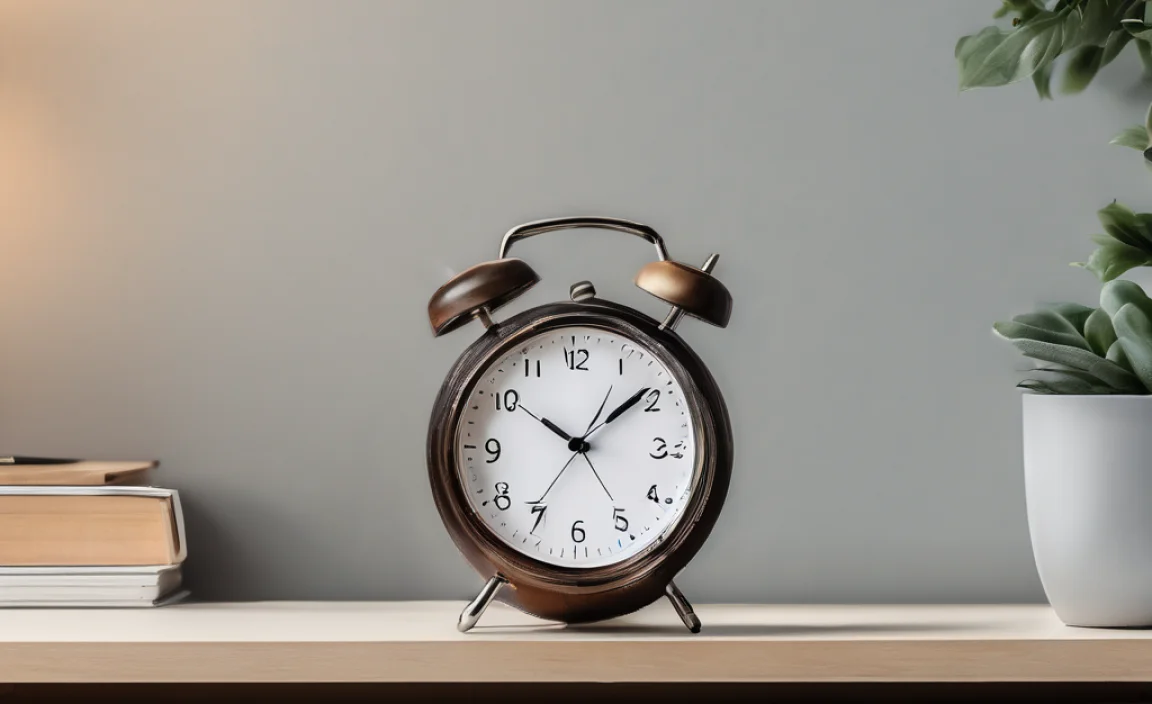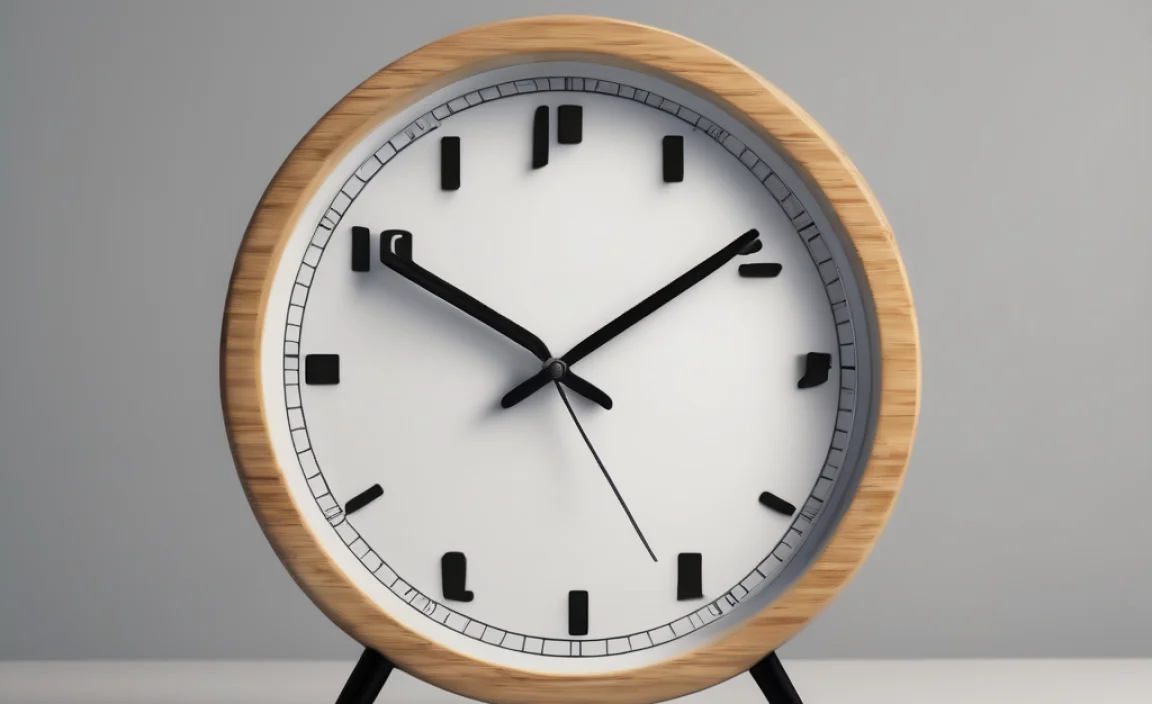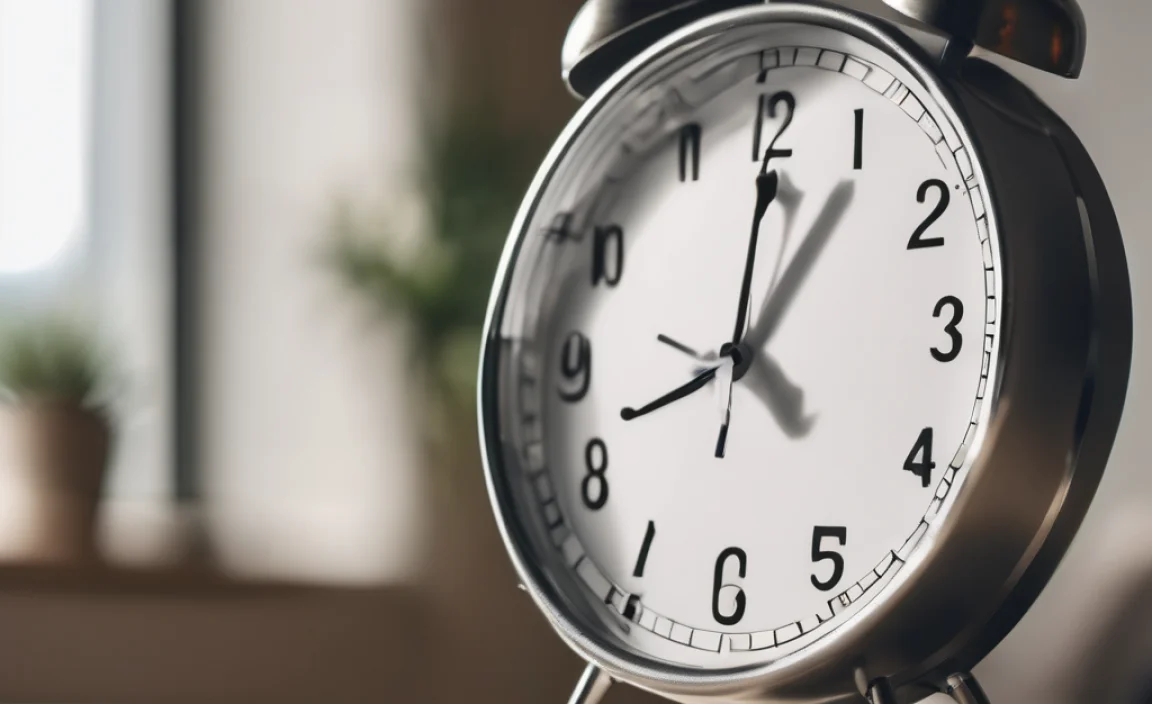A desktop clock for Windows 10 is an essential tool that enhances productivity and keeps you punctual. You can easily add or customize clocks on your Windows 10 desktop to suit your needs, from simple time displays to more advanced alarms and timers.
Desktop Clock for Windows 10: Your Essential Timekeeping Companion

Ever found yourself squinting at the small clock in the Windows taskbar, wishing for a clearer view? You’re not alone! Keeping track of time is crucial, whether you’re juggling deadlines, coordinating with others, or just trying to catch your favorite show. While Windows 10 has a built-in clock, sometimes you need more.
You might want a bigger display, a different style, or even extra features like alarms and timers right on your desktop. It can be frustrating when the default options don’t quite cut it. But don’t worry! This guide will show you how to easily get the perfect desktop clock for your Windows 10 setup. We’ll explore simple ways to add and customize clocks, making sure you’re always on time and in control.
Why You Need a Better Desktop Clock

The default clock in the Windows 10 taskbar is functional, but it’s often small and lacks customization. For many users, especially those who work with multiple time zones, need precise timing for tasks, or simply prefer a more visually prominent display, the built-in option falls short. A dedicated desktop clock widget can offer:
- Improved Visibility: Larger, clearer time displays that are easy to see at a glance.
- Customization: Options to change clock styles, colors, fonts, and transparency to match your desktop theme.
- Additional Features: Built-in alarms, timers, stopwatch functions, and even world clocks for different time zones.
- Enhanced Productivity: Keeping track of time without needing to constantly check the taskbar frees up mental space and can help you manage your schedule more effectively.
Understanding Windows 10’s Built-in Clock Options

Before we dive into third-party tools, it’s good to know what Windows 10 offers natively. While not as feature-rich as dedicated apps, the built-in clock can be adjusted to a degree.
Accessing and Customizing the Taskbar Clock
The primary clock in Windows 10 resides in the notification area (system tray) of your taskbar. You can slightly adjust its visibility and add more time zones.
- Right-click on the clock in the taskbar.
- Select “Adjust date/time.”
- In the “Date & time” settings, you can toggle “Set time automatically” and “Set time zone automatically.”
- Scroll down to “Additional clocks.”
- Check the box that says “Show additional clocks.”
- You can then select a time zone, enter a display name (e.g., “New York Time”), and click “OK.”
This allows you to have up to two extra clocks displayed when you hover over or click the main taskbar clock. While this is helpful for tracking different time zones, it doesn’t put a clock directly on your desktop.
The Alarms & Clock App
Windows 10 also includes an “Alarms & Clock” app. This app offers more robust features than the taskbar clock, including alarms, timers, a stopwatch, and a world clock. However, it doesn’t run as a persistent desktop widget.
- Search for “Alarms & Clock” in the Windows search bar and open it.
- Navigate through the different tabs (Alarm, Clock, Timer, Stopwatch) to explore its features.
While useful, this app needs to be open to use its more advanced functions, which isn’t ideal for a constant desktop display.
Adding a Desktop Clock Widget (The Easy Way!)

For a true desktop clock experience, third-party applications are the way to go. These are often lightweight widgets that you can place anywhere on your screen.
What to Look For in a Desktop Clock Widget
When choosing a widget, consider these factors:
- Ease of Use: Is it simple to install and configure?
- Customization Options: Can you change its appearance and features?
- Resource Usage: Does it slow down your computer? Look for lightweight options.
- Features: Do you need alarms, transparency, different time zones, or calendar integration?
- Security: Is the source reputable? Avoid downloading from untrusted websites.
Recommended Desktop Clock Widgets for Windows 10
Here are a few popular and reliable options, categorized by their primary strengths:
1. Desktop Gadgets (The Classic Approach – Requires a Bit More Setup)
While Windows 7 had built-in gadgets, Windows 10 doesn’t natively support them. However, there are ways to bring them back! This is a more involved process but offers a wide range of customizable gadgets, including numerous clock options.
How to Install Desktop Gadgets on Windows 10:
- Download a Gadget Installer: You’ll need third-party software to run these gadgets. A popular and well-regarded option is “8GadgetPack.” Search for it online from a reputable source (like their official website) and download the installer.
- Install 8GadgetPack: Run the installer and follow the on-screen prompts. It’s usually a straightforward installation.
- Add a Clock Gadget: Once installed, a gadget sidebar will appear. You can right-click on the sidebar (or anywhere on your desktop) and select “Gadgets.”
- Browse and Add Clocks: You’ll see a gallery of available gadgets. Look for clock gadgets (there are usually several variations, like analog, digital, world clocks). Double-click the clock gadget you like to add it to your desktop.
- Customize: You can drag the clock to your desired position on the desktop. Hover over the gadget, and you’ll typically see a wrench icon for settings. Click it to customize appearance, time zone, etc.
Pros:
- Huge variety of clock designs and styles.
- Many gadgets offer extensive customization.
- Can add other useful gadgets like calendars, system monitors, etc.
Cons:
- Requires installing third-party software (8GadgetPack).
- Gadgets are sometimes perceived as older technology, though they function well.
- Ensure you download 8GadgetPack from its official, secure source to avoid malware.
2. Rainmeter (For the Power User & Customizer)
Rainmeter is not just for clocks; it’s a powerful desktop customization tool that allows you to create and display highly customized skins on your desktop. This offers unparalleled flexibility but has a steeper learning curve.
How to Use Rainmeter for a Desktop Clock:
- Download and Install Rainmeter: Visit the official Rainmeter website (www.rainmeter.net) and download the latest version. Install it following the on-screen instructions.
- Download a Clock Skin: Rainmeter uses “skins” for its displays. You can find countless free clock skins created by the community on websites like DeviantArt, the Rainmeter subreddit, or dedicated Rainmeter skin sites. Search for “Rainmeter clock skin.” Download the `.rmskin` file.
- Install the Skin: Double-click the downloaded `.rmskin` file. Rainmeter will prompt you to install it.
- Load the Clock: After installation, Rainmeter will usually load the skin automatically, or you can open the Rainmeter manage window (usually found in the system tray), go to the “Skins” tab, find your newly installed clock skin, and click “Load.”
- Position and Customize: Drag the clock skin to your desired spot on the desktop. Most skins have configuration options that you can access by right-clicking them or through the Rainmeter manage window.
Pros:
- Ultimate customization: Create or install almost any clock design imaginable.
- Can integrate clocks with other system information (weather, CPU usage, etc.).
- Very lightweight once set up.
Cons:
- Steep learning curve: Requires more effort to set up and customize initially.
- Finding and installing skins can be a bit of trial and error.
- Requires careful selection of skins from reputable sources due to its flexibility.
3. Simple Standalone Clock Apps
Many developers offer simple, free applications that provide just a digital or analog clock widget. These are often the easiest to use.
Examples (Search for these names to find them):
- T-Clock Redux: A very popular and highly configurable taskbar clock replacement, but it can also display a standalone desktop clock. It offers a vast array of customization options for the clock display, including date, time, day of the week, and even calendar pop-ups. You can find it on GitHub.
- Atomic Clock Sync: While primarily for time synchronization, some versions or related tools might offer a desktop display.
- Various Desktop Clock Freeware: A quick search on download sites like MajorGeeks, FileHippo, or CNET Download for “Windows 10 desktop clock widget” will yield many results. Always scrutinize the source and check reviews before downloading.
How to Use (General Steps):
- Search and Download: Find reputable sites offering the app.
- Install: Follow the installer’s steps. Be mindful of any bundled extra software during installation.
- Launch: Run the application.
- Configure: Look for the app’s settings to choose clock style, size, color, transparency, and any other features.
Table: Ease of Use vs. Customization for Clock Options
| Method | Ease of Use (Beginner) | Customization Level | Resource Impact | Security Consideration |
|---|---|---|---|---|
| Windows Built-in (Taskbar Hover) | Very High | Low | Very Low | N/A (Built-in) |
| Windows Built-in (Alarms & Clock App) | High | Low (App Features) | Low (When Open) | N/A (Built-in) |
| Desktop Gadgets (via 8GadgetPack) | Medium | High | Medium | Download 8GadgetPack from official source. |
| Rainmeter (with skins) | Low (Initial Setup) | Very High | Low (Optimized) | Download skins from reputable communities. |
| Standalone Clock Apps | High | Medium to High (App Dependent) | Low to Medium | Download from trusted software sites only. |
Tips for Using Your Desktop Clock Effectively

Once you’ve chosen and installed your desktop clock, here are some tips to make the most of it:
- Placement is Key: Position your clock where it’s visible but doesn’t obstruct your work. Avoid covering important icons or windows.
- Match Your Theme: Choose a clock style and color that complements your Windows theme and wallpaper. Transparency can be a great way to make it blend in.
- Use Alarms Wisely: If your clock has alarm features, set them for important reminders, but avoid overusing them to prevent distractions.
- Consider Multiple Time Zones: If you work with people in different locations, a world clock widget can be invaluable for scheduling meetings and staying connected.
- Keep it Simple: Sometimes, the most straightforward digital clock is all you need for efficiency. Don’t overload your desktop with unnecessary widgets.
- Regularly Check for Updates: If you use a third-party clock app, check for updates periodically. These can include bug fixes and security improvements.
Troubleshooting Common Desktop Clock Issues
Even simple widgets can sometimes cause minor headaches. Here’s how to tackle them:
Clock Not Appearing After Installation
- Restart the Application: Close the clock application completely and relaunch it.
- Check System Tray/Gadget Bar: Ensure the gadget or app is running. Sometimes it hides in the system tray.
- Permissions: Some applications might require administrative privileges to run correctly or to “stay on top” of other windows.
- Compatibility: Ensure the clock widget or gadget pack is compatible with your version of Windows 10 (though most are designed for it).
Clock Freezes or Becomes Unresponsive
- End Task: Open Task Manager (Ctrl+Shift+Esc), find the clock application or gadget process, and click “End task.” Then, re-launch it.
- Check for Updates: An outdated version might have bugs.
- Resource Conflicts: If other demanding applications are running, it might cause your clock to lag. Close unnecessary programs.
Clock Disappears After Restarting PC
- Startup Settings: Most clock applications have a setting to “Run on startup” or “Start with Windows.” Make sure this option is enabled in the app’s preferences.
- Task Scheduler (Advanced): For some gadgets or custom setups, you might need to manually create a Task Scheduler entry to launch the clock when Windows starts.
Clock Overlaps Other Windows
- “Always on Top” Setting: Check the clock’s settings for an “Always on top” or “Pin to desktop” option. If enabled, you might need to disable it. Conversely, if you want it always visible, ensure this setting is active.
- Transparency/Sizing: Adjusting the clock’s transparency or size can help it blend better or become less intrusive.
Security Considerations for Desktop Widgets
While a clock widget is seemingly harmless, it’s essential to be security-conscious, especially with third-party software.
- Download from Official Sources Only: Always get software from the developer’s official website or well-established, reputable download portals like Microsoft’s security resources. Avoid pirated software sites or random download links.
- Read Reviews: Check user reviews when available to gauge reliability and potential issues.
- Antivirus Scan: It’s always a good practice to scan downloaded files with your antivirus software before installing them.
- Permissions: Be mindful of what permissions a widget asks for. A clock doesn’t need access to your personal files or webcam.
- Keep Software Updated: Developers often release updates to patch security vulnerabilities. Ensure your chosen clock widget or gadget pack (like 8GadgetPack) is kept current.
Conclusion: Master Your Time with a Desktop Clock
Adding a desktop clock to your Windows 10 system is a simple yet effective way to improve your daily workflow and stay organized. Whether you opt for the classic feel of gadgets, the ultimate power of Rainmeter, or the straightforward ease of a standalone app, there’s a solution for everyone. By following these steps, you can easily find, install, and customize a clock that not only tells time but also enhances your computing experience.
Remember to always prioritize security by downloading from trusted sources. With your new desktop clock in place, you’ll have a constant, clear reminder of the time, helping you stay punctual, productive, and in control. You’ve got this!
Frequently Asked Questions (FAQ)
Q1: Can I put more than one clock on my Windows 10 desktop?
Yes! If you use tools like 8GadgetPack or Rainmeter, you can often add multiple clock gadgets or skins, allowing you to display several time zones or different clock styles simultaneously.
Q2: Do these desktop clock widgets slow down my computer?
Most well-designed desktop clock widgets are very lightweight and have minimal impact on your system’s performance. However, very complex Rainmeter skins or multiple gadgets running at once could use slightly more resources.
Q3: How do I change the time zone on my Windows 10 desktop clock?
This depends on the clock application you’re using. Usually, you can right-click the clock widget and look for a “Settings,” “Options,” or “Configure” menu. There, you should find an option to select your desired time zone.
Q4: Are there any free desktop clock apps with alarms?
Yes, many free clock widgets and applications offer alarm functionalities. The built-in “Alarms & Clock” app in Windows 10 has these features, and many third-party options like T-Clock Redux also include alarm capabilities.
Q5: Can I make the desktop clock transparent?
Absolutely! Transparency is a common customization feature for desktop clock widgets. Look for a “Transparency” or “Opacity” setting within the clock’s configuration options.
Q6: Is it safe to download desktop clock software from the internet?
It can be safe, but you must be cautious. Always download from the official developer’s website or reputable software download sites. Avoid clicking on ads or downloading from unknown sources to prevent malware infections.
